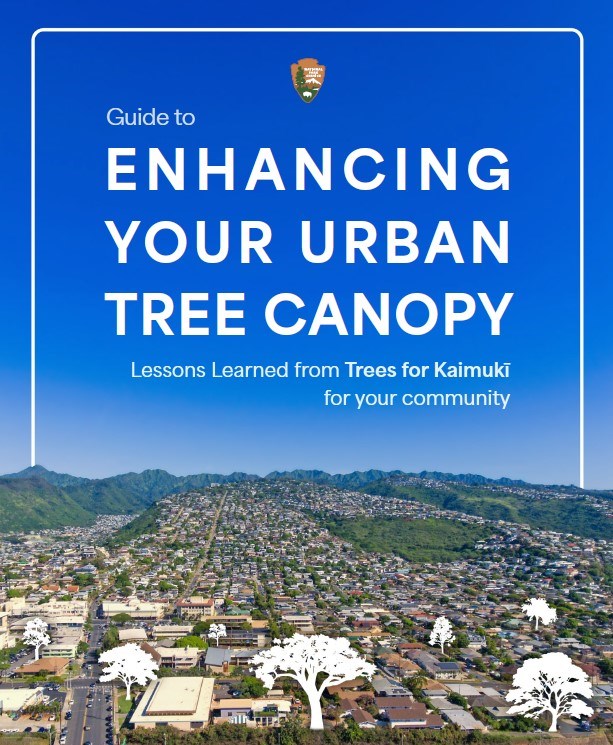Guide to Enhancing Your Urban Tree Canopy
Lessons Learned from Trees for Kaimukī - for your community.

Can Honolulu, the capital and most populous city in Hawai‘i, become a city in the trees? Can your city or neighborhood become one as well?
The answer is yes, but only if individual communities and neighborhoods are actively involved in—and feel a deep sense of connection and ownership over—the planning, planting, and care of their trees.
Located on the southeast coast of O‘ahu, the third largest of the Hawaiian Islands, Honolulu is losing its tree canopy at an alarming rate. In fact, it has recently lost more than 76,000 trees—nearly 5% of its total urban tree canopy—in just four years. Honolulu is not alone. Urban forests are declining in many cities across the United States. Research conducted by the U.S. Forest Service and others indicate that tree cover in urban areas is on the decline, with a national average of just 27 percent. Currently, Honolulu’s tree canopy averages only 20 percent, with some urban neighborhoods, like Kaimukī, having even less, according to the Honolulu Urban Tree Canopy Assessment and the Hawai’i Tree Canopy Viewer. When Kaimukī residents learned of this, they decided to take action.
Over the last five years, Trees for Kaimukī has made significant progress toward the goal of increasing the community’s urban tree canopy. Along the way, the organization has encountered—and overcome—challenges both great and small, from a pandemic to volunteer fatigue. There isn’t a magic formula or a one-size-fits-all approach that will work for every community, every time. Nor are any of the steps in the process a one-and-done task. Trees for Kaimukī learned—and relearned—the key lessons in this guide with each success and setback they had. Ultimately, Trees for Kaimukī hopes these lessons will make your community’s journey a little easier. Although the lessons are presented in a sequential order, they are interconnected. They highlight an ongoing cycle of interactions and feedback that builds upon itself to create a deeper and more meaningful connection with the community.
DOWNLOAD PDF: Guide to Enhancing Your Urban Tree Canopy
SELECTIVE MEDIA COVERAGE
University of Hawaii article on Kaimukī Library Tree Planting
Kaimukī Rain Garden Blessing Video Recap
Local television segment Hawaii News Now on a Kaimukī parklet
Highlighting local volunteers caring for the tree wells
Tree adoption event coverage on live local television
Local television segment by KHON-2 about the kickoff of Trees for Kaimukī
REFERENCES
Arbor Day Foundation. Alliance for Community Trees.
California Polytechnic State University. Urban Forest Ecosystems Institute.
Casey Trees. Tools for Urban Forestry.
City and County of Honolulu. (2019). Urban Tree Plan.
City and County of Honolulu, Office of Climate Change, Sustainability and Resiliency.
Hawai’i Division of Forestry and Wildlife et al. (2021). Hawai’i Tree Canopy Viewer.
Natural Areas Conservancy. Forests in Cities Network.
The Nature Conservancy Washington. Urban Tree Canopy Assessment Toolkit.
Nowak, David J. et al. (2001). Assessing the US Urban Forest Resources. Journal of Forestry.
Nowak, David J. et al. (2022). The disparity in tree cover and ecosystem service values among redlining classes in the United States. Landscape and Urban Planning.
Smart Trees Pacific. Honolulu Urban Tree Canopy Assessment.
Tree Equity Score.
University of Hawai‘i, Mānoa (2016). Kaimukī Community Report. Hawai’i Communities for a Lifetime.
US Forest Service. (2019). Urban Tree Canopy Assessment.
US Forest Service. Urban and Community Forestry Program.
Vibrant Cities Lab. Urban Forestry Toolkit.
World Economic Forum. (2022). The roots of sustainability: 5 reasons why cities need trees.
Last updated: November 26, 2024
